updated 10/19
WHY WE WANTED TO GO
Neither Stu nor I had been to The Alamo for decades. It is easy to overlook how significant a role The Alamo plays in America’s history.
Our generation grew up with Davy Crockett, Jim Bowie and Jim Travis. These men were our heroes. We were excited to see The Alamo! We looked forward to the moral lessons and action-packed episodes from those television shows coming back to us as we arrived. Instead, as adults, the sacrifice and bravery of the men who fought at the Alamo made us reverent and reflective.
We have put together the history of the Alamo and tips for visiting. Do not go to San Antonio without visiting the Alamo and honoring the events which took place there!
The first mission was built in Spanish Texas in 1690. The first of the missions to be built near San Antonio was San Antonio de Valero, now known as the Alamo Mission.
The missions were used to teach the local people the Spanish language, customs, and practices, provide basic education, indoctrinate locals to the Spanish rule and convert them to Catholicism. The missionaries also introduced European farming techniques, new machinery, and new crops to the region.
When the power of Spain in America (and the rise of power by the Republic of Mexico) began to decline, the missions faced financial hardship in the late 18th and early 19th centuries. As a result, the missions were all secularized by 1824. After secularization, many of them were largely abandoned and most fell into disrepair during the 19th century.
Five of the missions around San Antonio have been preserved. The four missions to the south of the city are now all active Catholic parishes, holding worship services. The Alamo has remained a tourist attraction.
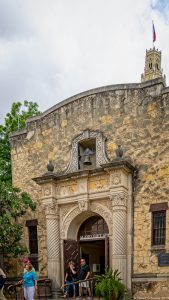
The Alamo has served many purposes over the past three centuries, as a Spanish mission, a military garrison, and a tourist attraction.
The Alamo as a Mission
The San Antonio de Valero mission (The Alamo) was the first Spanish mission to be built in what is now San Antonio area. It was established in May 1, 1718.
The original site of the mission in 1718 was San Pedro Springs.The present location of the Alamo mission was chosen in 1724 to avoid the frequent flooding. The stone mission church was built around 1744.
Over time, the original location expanded. The Mission San Antonio de Valero consisted of 3 acres, with farmland and pasture owned by the mission surrounding the complex. These structures included residences, barracks, a granary, and defensive structures to protect against Apache raids.
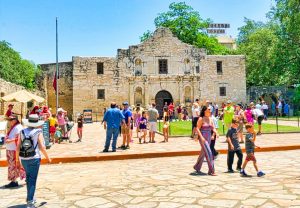
Apache attacks became more frequent in the 1800s and a change in a law of 1778 stated that all unbranded cattle belonged to the government. The law caused The Alamo to lose its wealth as people moved away.
In 1793, the mission was secularized and soon abandoned.
The Alamo as a Military Garrison
The complex remained unoccupied until 1803. It was also around this time that it became known as The Alamo. Over time, it served as a political prison and hospital. When Mexico gained independence in 1821, ownership of the complex was passed from the Spanish to the Mexicans.
The Mexicans used The Alamo as a garrison for Mexican forces. At the end of 1835, when Mexican forces surrendered it to the Texian Army.*
During the Texas Revolution, the Alamo was attacked by 1,500 Mexican soldiers. The Texians were surprised, outnumbered, and badly beaten during the Battle of the Alamo. The Mexican military took over the Alamo complex.
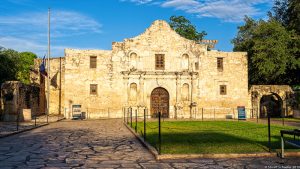
The loss at the Alamo was motivation for the Texians to continue fighting for their independence from Mexico. The battlecry “Remember the Alamo” is still well-known today.
Texans revere The Alamo as evidenced by our interview with a man visiting alongside us.
After the Texas Revolution ended, the Alamo was used for many purposes, destroyed and rebuilt. It was last used by the U.S. Army in 1876.
the Battle of the Alamo
The Battle of the Alamo lasted from February 23rd 1836 until March 6th 1836, and it was a pivotal moment in the Texas Revolution (also known as the War of Texas Independence).
The commanders of the siege were Sam Houston of the Texian Army and Antonio López de Santa Anna (often referred to just as Santa Anna) for the Mexican Army. The Alamo helped make men who fought on the Texian side more famous, including: Stephen Austin, Jim Bowie, Davy Crockett, Juan Seguín, and William Barrett Travis.
Mexican forces surrendered the Alamo at the end of 1835 to the Texian Army following the Siege of Béxar. The Alamo was left with only 100 men to defend it as the provisional government was in disarray and lacking troops and supplies.
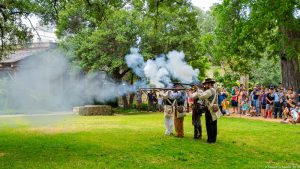
Colonel James Neill, the commander at the Alamo, saw the potential weakness of the Alamo as a defensible position in case the Mexicans decided to return. He asked the Texian government for additional help and supplies.
Some men were sent, including legendary frontiersmen David “Davy” Crockett and Jim Bowie. Neill left the Alamo in February 1836, to secure more men and provisions for The Alamo.
On February 23rd, 1836, the siege of the Alamo began. The attack lasted 13 days.
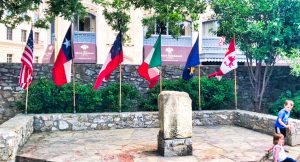
An additional 1,000 Mexican soldiers arrived on the scene on March 3.
On the evening of the 5th of March, the Mexican army ceased their artillery bombardment. The exhausted Texians fell asleep. The Mexican army advanced into an attack position, and the attack on the Alamo commenced at 5:30 a.m.
Despite repelling the first two major waves, the third wave of Mexicans was able to penetrate the Alamo.
Surviving Texian soldiers fell back to the barracks and chapel. The sheer number of the Mexicans meant defeat was inevitable, and by 6.30 a.m., the battle was over.
All or almost all the Texians were killed. William Travis, Davy Crockett, and James Bowie all died during the Battle of the Alamo. The Mexican Army was estimated to have lost between 400 and 600 troops during the Battle of the Alamo.
The Alamo is owned by the State of Texas. It became a UNESCO site in 2015. It is not only an historical structure and site but a shrine to the men who died fighting for their independence from Mexico.

GUIDELINES FOR A VISIT
There are rules of conduct for visiting The Alamo. After all, it is a church and a shrine. Guests are expected to behave respectfully, remove hats while visiting the church, and to dress appropriately.
See the full list of guidelines here. Plan to spend at least one hour once inside the grounds.
Most people start their tour at the church or mission building. No photographs are allowed inside. Movies and lore have made the church huge in our minds but be prepared; it is not very large.
When you exit the church, head to the Alamo Film and Long Barrack Museum.
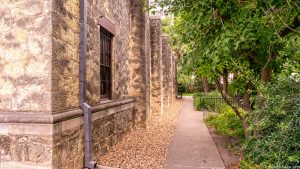
On the way, you will pass through the walled Convento courtyard, home to a large well. This was built when the Alamo was still a mission, and was in use during the Battle of the Alamo.
The Long Barrack Museum was the original home of the Spanish missionaries. It is the oldest building in San Antonio, built around 1724. During the Battle of the Alamo, it was the site of a last stand for many of the garrison’s soldiers, as they withdrew here when the courtyard was overcome.
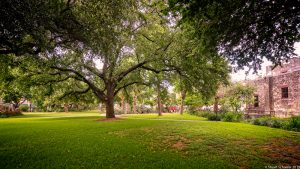
The Long Barrack is a museum which tells the story of the Alamo, and is home to many important artifacts and weapons from the battle. These include the letter from Colonel Travis pleading for reinforcements, the sword Travis wore when he was killed, and Davy Crockett’s shot pouch. There is also a list of all the known defenders of the Alamo.
Photography and videography is not allowed within the Long Barrack building.
Just next to the Long Barrack museum is the Cavalry Courtyard, which is home to several cannons which were used in the Battle of the Alamo.
Across from the Long Barrack Museum is the Wall of History, which has a mural that provides a full account of the 300 year-old history of the Alamo.
Living History Encampment
There is a living history encampment with weapons firing, period clothing demonstrations, fire starting, cooking, and leather making.
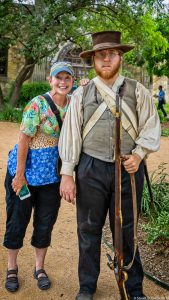
Look for:
- Alamo Cenotaph – Also known as the Spirit of Sacrifice, the memorial is situated just outside of the Alamo. It includes a list of names of most of the people who fought in the Battle of the Alamo on the Texian side. A few names, which were not known when it was built in 1936, are planned to be added.
- Alamo Walls – There are markings in some places on Alamo Plaza that show where walls would have been in front of the church. There is also a burial site.
- Commerce Street – Along Commerce Street there are plaques located near where it is believed that bodies of some of the Alamo defenders were burned on funeral pyres after the battle. There is also a plaque at the location of the former footbridge that was in use during the Battle of the Alamo.
- Ashes of the Alamo Dead – Inside the San Fernando Cathedral there is a marble coffin that is said to include the ashes of some of the defenders of the Battle of the Alamo, including Bowie, Crockett, and Travis. This may not be true but the church is interesting.
- Original Sites for the San Antonio de Valero mission – The Spanish mission was moved at least twice before it ended up at its present site. Although experts know broadly around where these would have been, the exact locations are unknown.
THERE IS AN IMAX FILM CALLED THE Price of Freedom
The film Alamo: Price of Freedom was created for IMAX in 1988. The film is 48 minutes long and is shown several times a day at San Antonio’s IMAX Theater located in the Rivercenter Mall. The mall is about a 6 minute walk from The Alamo historical site. You can see show times and ticket information here.
Tickets to the film are included for free if you have the San Antonio Super Saver pass.
PLANNING YOUR VISIT
HOURS:
Peak Season: (May 25-September 3): 9 a.m.-7 p.m.
Off-Peak Season: (September 4-May 24): 9 a.m.-5:30 p.m.
Extended Holiday Hours (November 30-December30): 9 a.m.-7 p.m. and Monday-Thursday; 9 a.m.-8 p.m. Friday-Sunday
Last entry is 15 minutes before closing time.
Closed on Christmas
ACCESSIBILITY TO SERVICES:
There are no cafes or restaurants at The Alamo, but there are vending machines with snacks and drinks on site. There are a number of different dining options within a few minute walk of the Alamo.
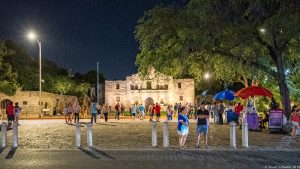
There is also a large gift shop, which is currently located in the 1937 Texas Centennial Museum building. Originally, this was built to honor the 100th anniversary of Texas independence.
All public areas of the Alamo are accessible to wheelchairs users; however, the historic flagstone floors are uneven in some of the structures and can present difficulties. Those in wheelchairs should seek assistance from Alamo staff about which doorways and paths are accessible.
PARKING
The Alamo doesn’t have its own parking, so you will need to find parking nearby in downtown San Antonio. This being a larger city, there isn’t much available free parking, so you’ll probably need to find a paid parking lot or garage. There are close parking locations such as Central Parking at 300 Avenue East (2 minute walk), Houston Street Garage at 240 East Houston Street (6 minute walk) or the Houston/Nolan lot (6 minute walk). You can see more parking options in San Antonio here.
Note that visitors with a valid U.S. disabled permit can park for free for short term visits at the downtown parking facilities run by the City of San Antonio.
COST
The Alamo is free to visit! You can go inside the church and walk around the grounds, as well as visit all the various buildings which are open to the public.
There is a fee if you wish to rent an audio guide or take a guided tour. The guided tours (as of October 2019) cost $15 per person, and audio guides are $7 per person. Military and veteran discounts are available.
TOURS
We took a self-guided tour but audio guides and guided tours can be booked in advance, and we recommend booking guided tours in advance to ensure you get your desired time slot.
If you want an audio guide (available in 5 languages), you can book online in advance, or pick one up on the day.
Guided tours last approximately one hour. Tours run throughout the day, and while walk up slots are kept open on a first come, first serve basis, it is wisest to book in advance online. You can read about the various tour options and book online here.
How to Avoid the Crowds at The Alamo
Here are tips to help avoid the crowds at The Alamo:
1.Visit off-season. Summer is the busiest time fo the year at The Alamo and you’ll find fewer travelers here at other times of year. Although note that school groups visit throughout the year.
2.Go early. Be there when it opens in the morning to be one of the first ones in before it gets too crowded. See the church first and then the Long Barracks as these are the two busiest areas.
3.If you can’t go early, try going late. Go a couple of hours before closing when most people have already visited for the day.
4.Book a private tour or an after-hours tour. As mentioned earlier, The Alamo staff run private tours during the day as well as limited evening group tours after the site has closed to the general public. These are limited in number and must be booked well in advance (normally 2 weeks or more).
5.Rent an audio guide. Having an audio guide can help you tune out the noise and crowds around you. You’ll also get more out of your visit.
CAN I GO to the OTHER 4 Missions in San Antonio?
Of course. Each of the four missions are located in the San Antonio Missions National Park and are around 2.5 miles apart, and the total distance between the four missions is about 6.5 miles. The first mission in the park, Mission Concepción, is around 2.5 miles south of the Alamo and downtown San Antonio.
Here is a map of the Alamo and the four missions of the San Antonio Missions National Historical Park.
If you want to visit all 5 missions in San Antonio, you’ll need at least half a day. Click here to see locations.
DIRECTIONS TO THE ALAMO & PUBLIC TRANSPORTATION
The Alamo is located in downtown San Antonio within Alamo Plaza.
The street address is: 300 Alamo Plaza, San Antonio, TX 78205. It is within walking distance of many of the downtown area hotels.
You can also get around San Antonio using public transport and several buses stop within a short walk of The Alamo. You can see the local public transit network schedules and information here.
The city’s hop-on hop-off sightseeing bus also stops at the Alamo. There are also taxis and Uber available in the city.
The Alamo’s telephone is: (210)225-1391 (main number)
Book a Tour: (210) 225-1391 ext. 4005
We viewed The Alamo in a completely different light as adults. We were overwhelmed by the history, sacrifice and bravery displayed at The Alamo. If you haven’t been, or haven’t been to The Alamo for a while, we urge you to visit. Let us know if you have any questions about planning a visit. We’ll be more than happy to help.